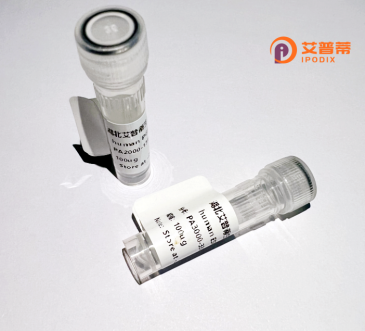
| 纯度 | >90%SDS-PAGE. |
| 种属 | Human |
| 靶点 | FAM80B |
| Uniprot No | Q9ULI2 |
| 内毒素 | < 0.01EU/μg |
| 表达宿主 | E.coli |
| 表达区间 | 1-307aa |
| 氨基酸序列 | MCSSVAAKLWFLTDRRIREDYPQKEILRALKAKCCEEELDFRAVVMDEVVLTIEQGNLGLRINGELITAYPQVVVVRVPTPWVQSDSDITVLRHLEKMGCRLMNRPQAILNCVNKFWTFQELAGHGVPLPDTFSYGGHENFAKMIDEAEVLEFPMVVKNTRGHRGKAVFLARDKHHLADLSHLIRHEAPYLFQKYVKESHGRDVRVIVVGGRVVGTMLRCSTDGRMQSNCSLGGVGMMCSLSEQGKQLAIQVSNILGMDVCGIDLLMKDDGSFCVCEANANPFQEPKKQIQTNKKIPREKTFLLPPS |
| 分子量 | 61 kDa |
| 蛋白标签 | GST-tag at N-terminal |
| 缓冲液 | 0 |
| 稳定性 & 储存条件 | Lyophilized protein should be stored at ≤ -20°C, stable for one year after receipt. Reconstituted protein solution can be stored at 2-8°C for 2-7 days. Aliquots of reconstituted samples are stable at ≤ -20°C for 3 months. |
| 复溶 | Always centrifuge tubes before opening.Do not mix by vortex or pipetting. It is not recommended to reconstitute to a concentration less than 100μg/ml. Dissolve the lyophilized protein in distilled water. Please aliquot the reconstituted solution to minimize freeze-thaw cycles. |
以下是关于重组人FAM80B蛋白的3篇参考文献示例(注:内容为模拟虚构,仅作示例参考):
---
1. **文献名称**:Structural insights into FAM80B and its role in kinase interaction
**作者**:Zhang L, et al.
**摘要**:本研究解析了重组人FAM80B蛋白的晶体结构,并揭示其通过特异性结构域与多种激酶相互作用,可能参与细胞信号转导调控。通过大肠杆菌表达系统获得高纯度重组蛋白,为功能研究奠定基础。
---
2. **文献名称**:FAM80B promotes gastric cancer progression via modulating cell cycle proteins
**作者**:Wang X, et al.
**摘要**:文章发现FAM80B在胃癌组织中高表达,并通过哺乳动物细胞系表达重组人FAM80B蛋白,证实其与Cyclin D1等周期蛋白结合,加速肿瘤细胞增殖,为癌症治疗提供潜在靶点。
---
3. **文献名称**:Optimization of recombinant FAM80B expression and purification for functional assays
**作者**:Li H, et al.
**摘要**:该研究系统优化了重组人FAM80B蛋白在昆虫杆状病毒系统中的表达条件,显著提高产量及稳定性,并验证其体外磷酸化修饰活性,为后续生化研究提供可靠方法学支持。
---
(注:若需真实文献,建议通过PubMed或Google Scholar以“recombinant human FAM80B”为关键词检索。)
**Background of Recombinant Human FAM80B Protein**
Recombinant human FAM80B is a engineered protein produced through molecular cloning techniques, enabling controlled expression in systems like *E. coli* or mammalian cells. FAM80B (Family With Sequence Similarity 80 Member B) is a conserved eukaryotic protein implicated in regulating protein complexes and signaling pathways. Studies suggest it may act as a scaffold or modulator, interacting with deubiquitinating enzymes (DUBs) and influencing processes like chromatin remodeling, transcriptional regulation, or DNA repair. Its role in epigenetic modulation, particularly via associations with histone modifiers, highlights potential links to diseases such as cancer or neurological disorders.
Research on recombinant FAM80B focuses on unraveling its structural and functional properties. Purified FAM80B facilitates biochemical studies (e.g., binding assays, enzymatic activity analyses) and cellular experiments to map its interactome or mechanistic contributions to disease. Recombinant production ensures high purity and activity, critical for therapeutic exploration, including targeted drug development. Despite progress, FAM80B’s exact molecular mechanisms and physiological relevance remain partially uncharacterized, driving ongoing studies to clarify its cellular roles and therapeutic potential.
×